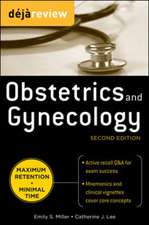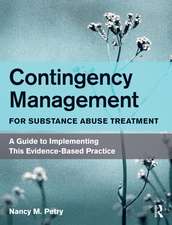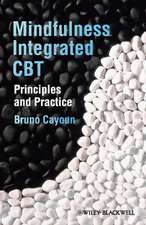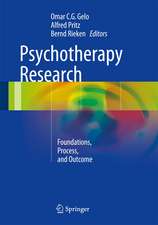Mind/Body Integration: Essential Readings in Biofeedback
Editat de S. Ancoli, Erik Peper, M. Quinnen Limba Engleză Paperback – 11 oct 2011
| Toate formatele și edițiile | Preț | Express |
|---|---|---|
| Paperback (1) | 931.82 lei 6-8 săpt. | |
| Springer Us – 11 oct 2011 | 931.82 lei 6-8 săpt. | |
| Hardback (1) | 937.94 lei 6-8 săpt. | |
| Springer Us – 29 iun 1979 | 937.94 lei 6-8 săpt. |
Preț: 931.82 lei
Preț vechi: 1136.37 lei
-18% Nou
Puncte Express: 1398
Preț estimativ în valută:
178.35€ • 185.88$ • 148.47£
178.35€ • 185.88$ • 148.47£
Carte tipărită la comandă
Livrare economică 06-20 ianuarie 25
Preluare comenzi: 021 569.72.76
Specificații
ISBN-13: 9781461329008
ISBN-10: 1461329000
Pagini: 612
Ilustrații: XX, 587 p.
Dimensiuni: 155 x 235 x 32 mm
Greutate: 0.84 kg
Ediția:Softcover reprint of the original 1st ed. 1979
Editura: Springer Us
Colecția Springer
Locul publicării:New York, NY, United States
ISBN-10: 1461329000
Pagini: 612
Ilustrații: XX, 587 p.
Dimensiuni: 155 x 235 x 32 mm
Greutate: 0.84 kg
Ediția:Softcover reprint of the original 1st ed. 1979
Editura: Springer Us
Colecția Springer
Locul publicării:New York, NY, United States
Public țintă
ResearchDescriere
Biofeedback training is a research methodology and training procedure through which people can learn voluntary control over their internal physiological systems. It is a merger of mUltiple disciplines with interest deriving from many sources-from basic understanding of psychophysiology to a desire for enhanced self-awareness. The goals of biofeedback are to develop an increased awareness of relevant internal physiological functions, to establish control over these functions, to generalize control from an experimental or clinical setting to everyday life, and to focus attention on mind/body integration. Biofeedback is explored in many different settings. In the university, biofeed back equipment and applications can be found in the departments of experi mental and clinical psychology, counseling, physiology, biology, education, and the theater arts, as well as in the health service (student infirmary). Outside the university, biofeedback may be found in different departments of hospitals (such as physical medicine), private clinics, education and self-awareness groups, psychotherapy practices, and elsewhere. Its growth is still expanding, and excite ment is still rising as a result of biofeedback's demonstration that autonomic functions can be brought under voluntary control and that the long-standing arti ficial separation between mind, body, and consciousness can be disproven.
Cuprins
Section I General Overview of Biofeedback: An Introduction.- 1 Learned Control of Physiological Function and Disease.- 2 Control of States of Consciousness: Attainment through External Feedback Augmenting Control of Psychophysiological Variables.- 3 Biofeedback and Physiological Patterning in Human Emotion and Consciousness.- 4 Problems in Biofeedback Training: An Experiential Analogy—Urination.- 5 Clinical Applications of Biofeedback Training: A Review of Evidence.- 6 The Possible Uses of Biofeedback in Education.- 7 Passive Attention: The Gateway to Consciousness and Autonomic Control.- 8 Biofeedback for Mind/Body Self-Regulation: Healing and Creativity.- 9 The Two Endpoints of an EEG Continuum of Meditation—Alpha/Theta and Fast Beta.- 10 Biofeedback Training: Holistic and Transpersonal Frontiers.- Section II. Complementary Techniques.- 11 About the Methods of Autogenic Therapy.- 12 Progressive Relaxation Training: Overview. Procedure, and Implications for Self-Regulation.- 13 Beliefs and Attitudes: Their Significance in Therapeutics.- 14 Biofeedback Treatment in Medicine and Psychiatry: An Ultimate Placebo?.- 15 Belief in Biofeedback for the Control of Short-Term Stress.- Section III Technical Considerations in Biofeedback.- 16 A Beginner’s Behavioral Test Guide to Biofeedback Instrumentation.- 17 Common Errors Made during Biofeedback Training and Research Studies.- 18 Biofeedback Equipment.- 19 Electrodes.- 20 Standard Specifications for the Description of Biofeedback Instruments.- 21 A Bioelectric Glossary.- Section IV. Electroencephalography Biofeedback.- 22 Brain Rhythms and the EEG.- 23 Electroencephalography.- 24 Autoregulation of the EEG Alpha Rhythm: A Program for the Study of Consciousness.- 25 Detection of EEG Abnormalities with Feedback Stimulation.- 26 Feedback Regulation of the Alpha Electroencephalogram Activity through Control of the Internal and External Parameters.- 27 On the Mechanisms of the Feedback Control of Human Brain-Wave Activity.- 28 Alpha Biofeedback Training: Some Methodological Issues and Future Considerations.- 29 Effects of Central Cortical EEG Feedback Training on Incidence of Poorly Controlled Seizures.- Section V. Electromyography Biofeedback.- 30 Muscle Action and the Sensory System.- 31 Control and Training of Individual Motor Units.- 32 Facts versus Myths in EMG Biofeedback.- 33 Dysponesis: A Neurophysiologic Factor in Functional Disorders.- 34 Cultivated Low Arousal—An Antistress Response?.- 35 EMG Training and Headache Reduction: Some Methodological Issues.- 36 Paraprofessional Relaxation Training Technicians in a Biofeedback Clinic.- 37 EMG Biofeedback in Physical Therapy.- Section VI. Cardiovascular Biofeedback I—Temperature.- 38 Feedback-Aided Self-Regulation of Skin Temperature with a Single Feedback Locus: Acquisition and Reversal Training.- 39 Thermal Biofeedback Training in Children with Headache.- 40 Psychosomatic Self-Regulation of Migraine Headaches.- Section VII. Electrodermal Biofeedback.- 41 Galvanic Skin Reflex.- 42 GSR Biofeedback in Psychotherapy: Some Clinical Observations.- Section VIII. Cardiovascular Biofeedback II—Hypertension.- 43 Blood Pressure.- 44 12-Month Follow-Up of Yoga and Biofeedback in the Management of Hypertension.- 45 Randomized Controlled Trial of Yoga and Biofeedback in Management of Hypertension.- Section IX Other Applications.- 46 Operant Conditioning of Rectosphincteric Responses in the Treatment of Fecal Incontinence.- 47 The Use of Biofeedback Devices in the Treatment of Bruxism.- 48 Economical Biofeedback Devices.- Conclusion.- Name Index.














